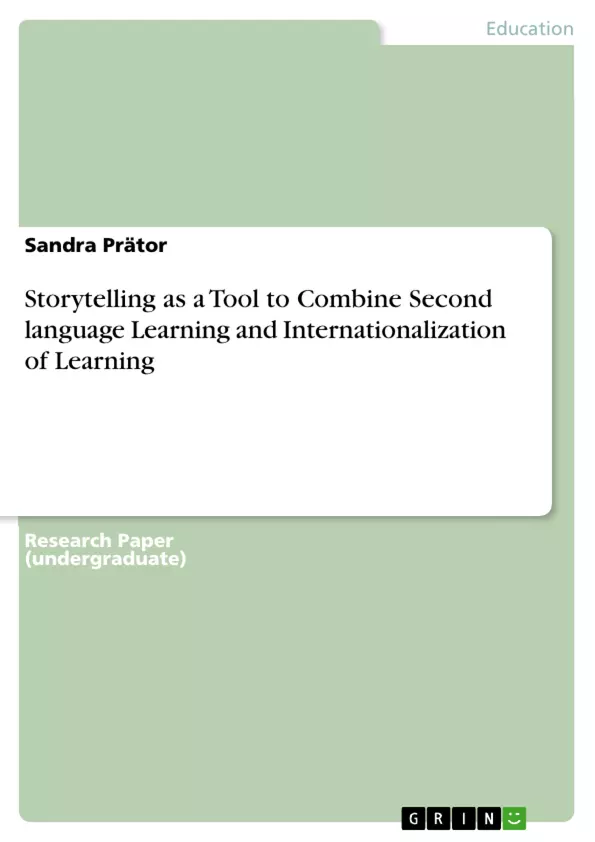The following paper was developed in the context of internationalization in education and how international education can be promoted. According to a popular online encyclopedia, internationalization in a broader sense can be regarded as international activities, mostly regarded in an economic sense as the process of increasing involvement of enterprises in international markets (see: Wikipedia/internationalization) However, international activities in the economy not only affect economies itself but also societies worldwide. Therefore, people involved need to adapt their perspective from a national towards a more international one. Thus, activities towards internationalization should first of all be promoted in education for students to acquire the necessary intercultural knowledge to be equipped with the necessary competencies to become a global citizen.
Inhaltsverzeichnis (Table of Contents)
- Introduction
- Main Part - Second Language Learning and Storytelling
- Storytelling as a Tool to Combine Second Language Learning and Internationalization
- Second Language Acquisition and Second Language Learning
- Storytelling
- Conclusion:
- Project Close-up
- Project Abstract
- The Project in Detail
- Mode of the Project - Exchange.…
- Objectives and Potential Project Results
- Objektives
- Potential Project Results:
- Optional Project Results
- The Project Consortium and their Tasks…
- Project Partners
- Associated Partners
- Tasks
- Prerequisites – Before the Project and the Project Meetings.
- During the Project – Project Program
- First Project Meeting – The Beginning of a Story.
- Second Meeting – A Story Unfolds
- Third Meetings - A Story Comes to an End…
- Use of Material and Integration of ICT.
- After the Project Meetings - Follow-up Phase
- Challenges and Limitations of the Project
- Conclusion and outlook
- Exploitation and Sustainability Strategy.
- Resources…
Zielsetzung und Themenschwerpunkte (Objectives and Key Themes)
This paper explores the role of internationalization in education, specifically focusing on how foreign language learning, particularly storytelling, can foster intercultural understanding and promote international education in schools. The project aims to demonstrate a practical approach for integrating storytelling as a means of second language learning into a school's profile, curriculum, and policy, thereby contributing to internationalization efforts.
- Internationalization in Education
- Second Language Acquisition and Learning
- Storytelling as a Tool for Intercultural Learning
- Integrating Storytelling into Language Learning
- Promoting Internationalization Through Project Collaboration
Zusammenfassung der Kapitel (Chapter Summaries)
- Introduction: This chapter provides a broad overview of internationalization in education, highlighting its importance in a globalized world. It emphasizes the role of acquiring inter-cultural knowledge and competencies for becoming a global citizen and discusses various strategies for implementing internationalization in school curricula. The project aims to show how storytelling can be integrated into foreign language learning to enhance internationalization in schools.
- Main Part - Second Language Learning and Storytelling: This section explores the theoretical foundation for second language learning and the potential of storytelling as a tool for promoting language acquisition and intercultural understanding. It delves into the process of second language acquisition and learning, highlighting different stages of development and factors influencing learners' progress. The chapter then discusses storytelling as a valuable tool for language learning, emphasizing its role in cultural transmission and its ability to foster empathy and perspective-taking.
- Project Close-up: This chapter presents a detailed overview of the project designed to implement storytelling as a means of promoting internationalization through second language learning. It outlines the project's objectives, potential results, and the tasks involved for the consortium of project partners. The chapter also details the project's implementation strategy, including the use of technology and the planned follow-up phase.
Schlüsselwörter (Keywords)
The key concepts and themes of this paper revolve around the interplay between second language learning, storytelling, and internationalization in education. The project highlights the potential of storytelling to bridge cultural divides, foster language acquisition, and promote intercultural understanding within a globalized world. Key terms include internationalization in education, second language acquisition and learning, storytelling, inter-cultural learning, and project collaboration.
- Quote paper
- Magister Artium Sandra Prätor (Author), 2014, Storytelling as a Tool to Combine Second language Learning and Internationalization of Learning, Munich, GRIN Verlag, https://www.grin.com/document/429124



